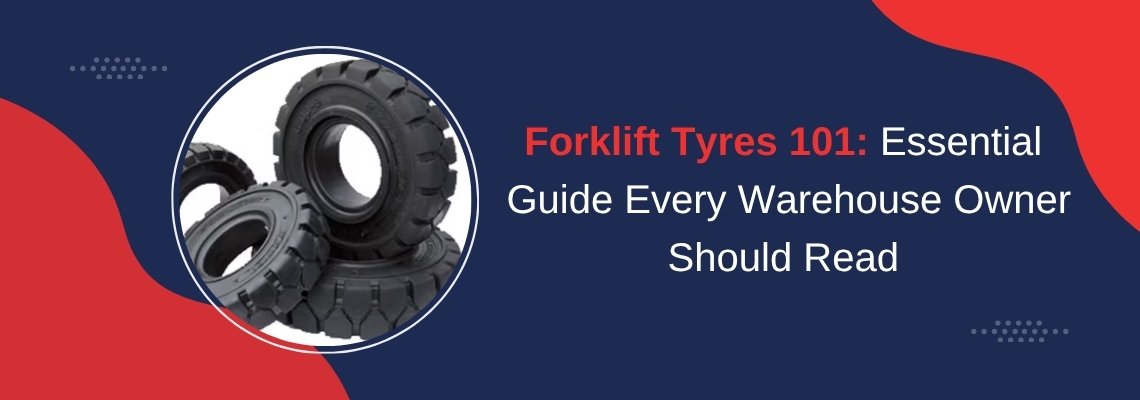In the fast-moving world of warehousing, your forklifts are the muscle that keeps operations running smoothly. Yet, one element often overlooked is also one of the most critical; the tyres. The right choice and care of forklift tyres warehouse owners depend on can dramatically impact efficiency, safety, and cost savings. This guide breaks down everything from tyre types and usage tips to maintenance best practices that every operations manager should know.
Why Forklift Tyres Matter
Forklift tyres directly impact grip, stability, and load handling. The wrong tyre can increase wear and tear on your forklift, cause operator discomfort, and even pose safety risks. Choosing tyres based on your floor type, load capacity, and operating conditions ensures better performance and longer equipment life.
Different Types of Forklift Tyres
-
Pneumatic Tyres
Pneumatic tyres are filled with air, similar to truck tyres, and are ideal for outdoor and rough surfaces. Their thicker tread provides excellent traction and shock absorption, making them perfect for use on gravel, concrete, or uneven terrain.
- Best for: Construction yards, loading docks, and outdoor operations.
- Benefits: Cushioned ride, stability, and durability.
-
Solid Tyres
These are made of solid rubber, making them puncture-proof and maintenance-free. While they are more costly than air-filled types, they provide a longer lifespan and excellent resistance to wear from debris and rough surfaces.
- Best for: Recycling yards, manufacturing units, and heavy-duty environments.
- Benefits: No flats, longer life, and reduced downtime.
-
Polyurethane Tyres
Used primarily on electric forklifts and pallet trucks, polyurethane tyres provide good traction with minimal rolling resistance. They are suitable for long runs on smooth indoor floors and light-duty operations.
- Best for: Cold storage, clean environments, and indoor applications.
- Benefits: Lightweight, efficient, and resistant to surface marking.
Choosing the Right Tyre for Your Forklift

When selecting tyres, consider these key factors:
- Operating Environment: Indoor warehouses demand cushion or polyurethane tyres, while outdoor settings require pneumatic types.
- Load Capacity: Heavier loads benefit from solid pneumatic tyres for strength and stability.
- Surface Type: For smooth floors, cushion tyres are ideal; for uneven terrain, pneumatic tyres are preferred.
- Frequency of Use: Intensive use justifies durable, solid tyres to minimize changeovers.
A forklift operating on the wrong tyre type can cause energy inefficiency, higher fuel consumption, and more frequent breakdowns. The selection directly ties to safety, operating costs, and equipment longevity.
Forklift Tyre Maintenance Tips
-
Regular Inspections
Check for cracks, cuts, chunking, or uneven wear. Tyres with deep wear lines or flat spots should be replaced immediately to prevent accidents and uneven lifting.
-
Maintain Proper Inflation
For pneumatic tyres, monitor air pressure daily. Incorrect inflation can cause reduced stability or excessive wear. Never bleed air to reduce pressure, as it increases heat buildup over time.
-
Rotate and Realign
Rotating tyres at scheduled intervals ensures even wear and maximizes their lifespan. Keeping the forklift axle aligned helps distribute weight evenly and prevents premature damage.
-
Drive Smart
Avoid sudden braking, tight turns, and over-speeding; these habits can reduce tyre life by up to 30%. Train operators to handle forklifts smoothly and respect payload capacities to prolong tyre and vehicle efficiency.
-
Replace at the Right Time
Following manufacturer guidelines, replace tyres when 25–30% of tread wear is visible for cushion tyres and 75–80% for solid pneumatic variants. Delaying replacement risks uneven lifting and potential tipping incidents.
Environmental and Cost Advantages
Switching to high-resilience or non-marking tyres not only reduces carbon emissions but also enhances sustainability within indoor facilities. Forklift tyres with better rolling resistance can cut fuel or energy costs by 10–15%, positively impacting long-term operational budgets.
Conclusion
For warehouse owners and procurement managers, understanding forklift tyres warehouse owners rely on is more than just technical knowledge; it’s a cost-saving strategy that elevates safety and performance. By choosing the right tyre type, staying consistent with inspections, and adopting efficient driving habits, you protect both your operators and investment.
For expert guidance on tyre selection or service, reach out to specialists in Forklift service in Coimbatore trusted partners for maintaining your forklifts at peak efficiency.

